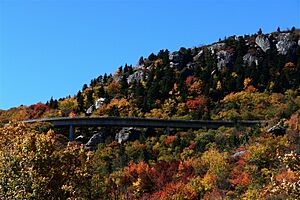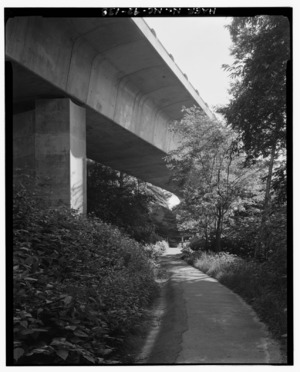Linn Cove Viaduct facts for kids
Quick facts for kids Linn Cove Viaduct |
|
|---|---|
 |
|
| Coordinates | 36°05′42″N 81°48′44″W / 36.09513°N 81.81223°W |
| Carries | Blue Ridge Parkway |
| Crosses | Linn Cove of Grandfather Mountain |
| Locale | Avery County, NC |
| Owner | National Park Service |
| Maintained by | National Park Service |
| Characteristics | |
| Design | Segmental bridge |
| Material | Concrete |
| Total length | 1,243 feet (379 m) |
| Width | 39.5 feet (12.0 m) |
| Longest span | 180.1 feet (54.9 m) |
| History | |
| Designer | Figg & Muller Engineering Group |
| Constructed by | Jasper Construction Co. |
| Construction begin | 1979 |
| Construction end | 1983 |
| Construction cost | $10 million |
| Inaugurated | September 11, 1987 |
The Linn Cove Viaduct is a super cool bridge in western North Carolina. It's made of concrete and is about 1,243 feet (379 meters) long. This bridge looks like a giant snake winding around Grandfather Mountain!
It was finished in 1983 and cost about $10 million. This was one of the last big projects for the Blue Ridge Parkway. The parkway is a famous road that stretches 469 miles (755 km). It connects Shenandoah National Park to Great Smoky Mountains National Park. The Linn Cove Viaduct helped complete this amazing road in 1987.
Contents
Building the Linn Cove Viaduct
Building the Blue Ridge Parkway started way back in 1935. The original plan for this part of the road was to build a special bridge. This was because a regular road would harm Grandfather Mountain.
Grandfather Mountain is a very old and rugged peak. It stands almost 6,000 feet (1,829 meters) tall. People who wanted to protect the mountain pushed for the bridge idea. They worried that logging and other activities would damage its natural beauty. They also wanted to keep the amazing views of the mountain.
By 1966, most of the parkway was done. But a 7.7-mile (12.4 km) section around Grandfather Mountain was still unfinished. It took 40 years for the government to get all the land needed for this part.
How the Viaduct Was Designed and Built
The Linn Cove Viaduct was designed by Figg and Muller Engineers, Inc. Construction began in 1979. The bridge is about 1,243 feet (379 meters) long and nearly 40 feet (12 meters) wide. It rests on seven strong piers.
What made this bridge special was how it was built. Workers kept heavy construction equipment off the ground. Even the first studies in 1975 used helicopters to lower drilling equipment. This helped protect the mountain's delicate environment.
The bridge was built by connecting 153 concrete pieces. Each piece was about 8.5 feet (2.6 meters) long and weighed 50 tons. These pieces were made nearby and moved to the bridge by a special crane. The crane moved along the bridge as it was being built.
Almost all the pieces were slightly curved. This allowed the viaduct to gently follow the mountain's shape. It looks like an "S-and-a-half" figure. The only work done on the ground was drilling for the piers.
The Linn Cove Viaduct has won many awards for its design. One award in 1984 praised its "elegant curving ribbon." It makes drivers feel like they are "driving tantalizing on air."
Exploring the Area
The National Park Service runs the Linn Cove Visitor Center. It's located at the south end of the viaduct. The center has a bridge museum where you can learn more about this amazing structure.
You can also access the Tanawha Trail from here. This trail is great for hiking and runs from Beacon Heights to Julian Price Memorial Park.
See also
- List of bridges documented by the Historic American Engineering Record in North Carolina




